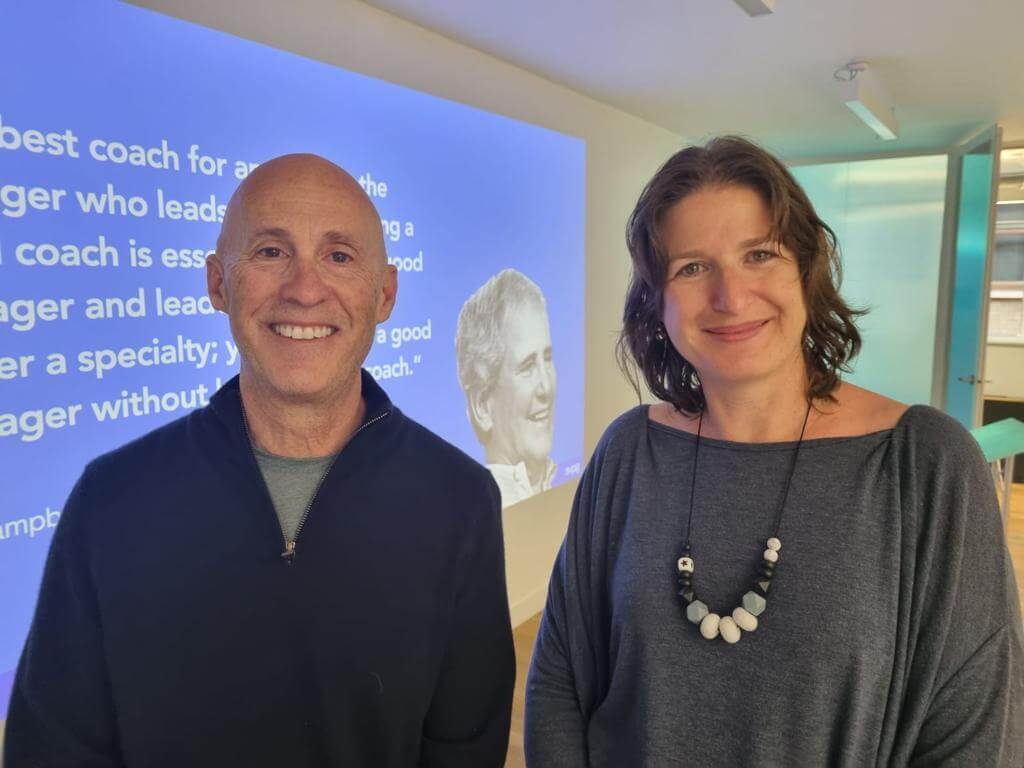Quite a few weeks have passed since I attended SVPG’s ‘Coach the Coaches’ session. I went back to my normal life, personal and professional. But every now and then, for example, when I share the insights with my customers (many of them wanted to use our time together to simply hear how it was), I remember what a great privilege it was to attend this workshop, and I feel truly grateful.
One of the best outcomes is of course the networking that happened during these three days. I got to meet 50 great product coaches from all over Europe, and of course, got to meet and connect with Marty and his partners. They are all absolutely amazing. I wasn’t exposed to the partners’ work before, but they are great product leaders with tons of great advice and inspiration. Some of the insights in this part of the summary have come from the stories and thoughts shared by the partners.
The first part of this summary focused more on the execution side of things: I talked about discovery, processes, and team structure. Today I will focus more on leadership and strategy.
As a reminder, these are my thoughts and insights from the workshop, listed here in no particular order.
The 4 Risks
In the second edition of his book ‘Inspired’, Marty Cagan describes the 4 risks that any product manager needs to manage at all times:
- feasibility risk (can we do it)
- usability risk (will they be able to use it)
- value risk (would they use it and buy it)
- business viability risk (is it good for our business)
As a strategic product leadership coach, almost everything I deal with is around value and business success, so I never found this framework very useful. I also never connected to the term business viability, and always preferred business success.
One thing Marty said in the workshop, however, made me quote this framework much more and use it when I help my customers understand where they should focus their energy. In fact, it gave me a boost of confidence that what I do is important. Marty said that most companies spend most of their time trying to minimize the feasibility and usability risks, but the far more important risks to manage are the value and business viability risks. They are also the hardest to minimize.
It was one of those moments that I found myself nodding my head in agreement as boldly as one could. That’s primarily what I help companies do, and I know firsthand that it’s really hard. But it really pays off when done right.
Strategy and Focus
It almost doesn’t matter what drove a company to work with me originally, at some point we get to strategy. Strategy is so hard to craft and too often overlooked. This is especially true with product strategy, which is still an artifact that most CEOs haven’t seen a great one in action before.
Marty created a guideline that resonates exactly with what I see: constant prioritization is needed when there is a lack of strategy. If you find yourself constantly needing to decide what to do, and too confused between the options, you probably haven’t created the strategy that would lead the way. A good strategy requires making hard decisions, but once those are made, everything becomes much clearer along the way.
One other quote that Marty mentioned was by Steve Jobs: “People think focus means saying yes to the thing you’ve got to focus on. But that’s not what it means at all. It means saying no to the hundred other good ideas that there are.”
That’s what makes it so hard! Especially with startups, by the way, which Marty mentioned to be “so easily distracted”. There is a fine line between ruthless focus and unwillingness to change. That’s where another quote by Jeff Bezos comes in handy: “Be stubborn on the vision but flexible on the details”. The problem is that for startups, even the vision needs to be very flexible, so staying focused is much harder – and much more important as well.
Amazon and Stripe both use a mantra that says “think deeply, move quickly”. A good product strategy helps exactly with that, not only in the sense that a good strategy makes execution much easier but also in the sense that the goal is no longer time to market, it should be time to outcome, or time to money if you prefer that and are in the relevant stage.
Another strategic note about startups that almost goes without saying if you follow my writing, is that before you have product-market fit, finding it should be your only focus. A common pitfall that I often see is that companies declare that they have product-market fit way before they actually do (usually when they have problem-solution fit, which is defined as having a small number of happy paying customers).
Communication
To craft a good strategy, Marty recommends writing it down. Since I’m a big believer in that as well, here is my quick take on this: Writing helps crisp up your thoughts. It’s very different to have a general thought somewhere at the back of your head from having to clearly articulate it in writing. Words matter as much as nuances matter, and the specific phrasing you choose can make the difference between good and great.
Writing your strategy also helps in another way: it helps you share it with others. Not necessarily the raw document where you wrote your thoughts, but once you found the right words and logical explanations sharing them with the team becomes much easier.
I have said it before, and Marty said it again: You should constantly and continuously share the strategic context with everyone. Don’t assume they know it just because they heard it once. Don’t assume that if they heard it multiple times they understood it. Don’t assume that if you have explained it to them they remember the details, although it does help if told the right way.
Working With Stakeholders
One of the things that stood out to me when we were talking about stakeholders was how personal this all is. Marty said that as a product leader you will be judged by the weakest PM in your team. Judged is a strong word – but better said out loud in this context: Yes, you will be judged. They will judge you first and foremost, way before they can or will judge the process, or the strategy, or the product, or the team. You should build personal trust before you build professional trust.
One great way to do it is to truly bring empathy to your work with stakeholders. Yes, the same one you do with your customers: What is it that they really need, even if it’s not what they tell us? Express genuine interest in what they need and are trying to achieve. One of the product leaders I work with just shared with me that when he approached the executive he had the hardest time working with, with empathy and the understanding that they need to build personal trust first, he realized that they actually want the same thing for the company, and started collaborating on that. The other executive felt the same, by the way, and said something like “it was the best meeting I have ever had”.
One very special stakeholder is, of course, the CEO. I have written about it a lot and was delighted to hear that Marty recommended the same approach that I have been preaching for years: First of all, the CEO should feel ownership of the product vision, even if it is yours to craft. They have a right and responsibility to impact it. In startups, the product vision is even more critical, as it has so much in common with the actual company vision and strategy.
Next, when the CEO comes up with a product idea, you should share with them what you understood and ask them if you got it right. You need to try to make sense of it for them because they won’t always be able to translate their thoughts into crisp product ideas. Take the idea as a conversation started, and dig deeper to see what is it that they really want to say.
Product Leadership
Last but not least, is my favorite topic of the role of the product leader. Hearing Marty saying that a common product leadership issue is that “leaders lack the moral authority of a founder” was music to my ears. Your role is much bigger than you think. You lead the company through the product, not the product team alone.
With great power, though, comes great responsibility. To lead well, you must understand the business context. Being business savvy is a must-have for anyone in the c-suite, Marty said and I couldn’t agree more. But please don’t think that you should start worrying about it only when are formally appointed CPO. Even if you are “just” head of product, for example, you still need to think and operate with the business perspective in mind.
One of the most common complaints I hear from product leaders is that the organization is too sales-driven. Here, too, comes your responsibility: if your company is sales-driven, it’s because you haven’t done your job of showing them another way, Marty said. When there is a vacuum, sales will fill it. But it’s on you to change it.
Your responsibility spans much broader than your authority, as we all know. That’s why Marty believes that the product leader should be responsible for the business outcomes (e.g. ARR) even if they can’t impact it directly by managing the sales team. There is so much indirect impact that you can make, and by seeing yourself responsible for that you will be a much better product leader.
We started with coaching and I’ll end with coaching. One more thing that Marty and I both say is that as a product leader, the skills that got you here aren’t the skills that will help you succeed. That’s true almost universally with any promotion, but I believe that the move from a product manager or even a manager of a product team in a larger organization to be the product leader as a whole is one where this gap truly shows.
Coaching is a great tool to keep pace. Thank you, Marty and the SVPG team, for giving us an opportunity to learn from you so closely. You are an inspiration for a better product world.









